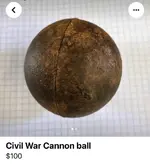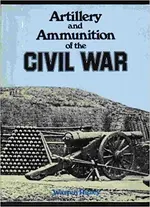The presence of a casting-mold seam on a "maybe-cannonball" is not a 100%-qll-the-time disqualifier for being a cannonball. Many RevWar cannonballs have a distinct moldseam, especially the ones made by the Colonials. But of course, more often than not, a ball with a moldseam is a 20th-Century Industrial ball, such as a rock or ore-crusher ball ("Mill-Ball").
So, since you cannot rely on a moldseam telling you a definite yes or No, you'll need to get precise weight and diamter measurements for that Facebook "maybe-cannonball." Most people do not own a digital caliper of a P-tape (diameter-measuring tape). But most people put the ball into a small paper sack and take it to a local grocery store's Produce section, and weigh the ball on the vegetable-weighing scale their. Although a produce-weighing scale is not as accurate as a Postal Shipping scale, it does weigh in pounds-&-ounces. The grocery's scale might be an ounce or two off, but that is close enough to tell you whether or not it is an actual cannonball.
Note:
I specified a grocery scale of Postal Shipping scale because typical household bathroom weighing scales are notoriously inaccurate, and thus are worthless for cannonball identification.
To view very-precise diameter and weight charts for civil war and RevWar cannonballs (and grapeshot balls, etc.), go here:
www.civilwarartillery.com/shottables.htm
While we wait for the ball's weight:
What's more "worrisome" to me at this point is the fact that the Facebook ball is rusty but shows basically NO PITTING-CORROSION at all. You very rarely see an excavated civil war cannonball without at least SOME rust-pitting corrosion. But industrial Mill-Balls are always quite smooth, like this ball.





